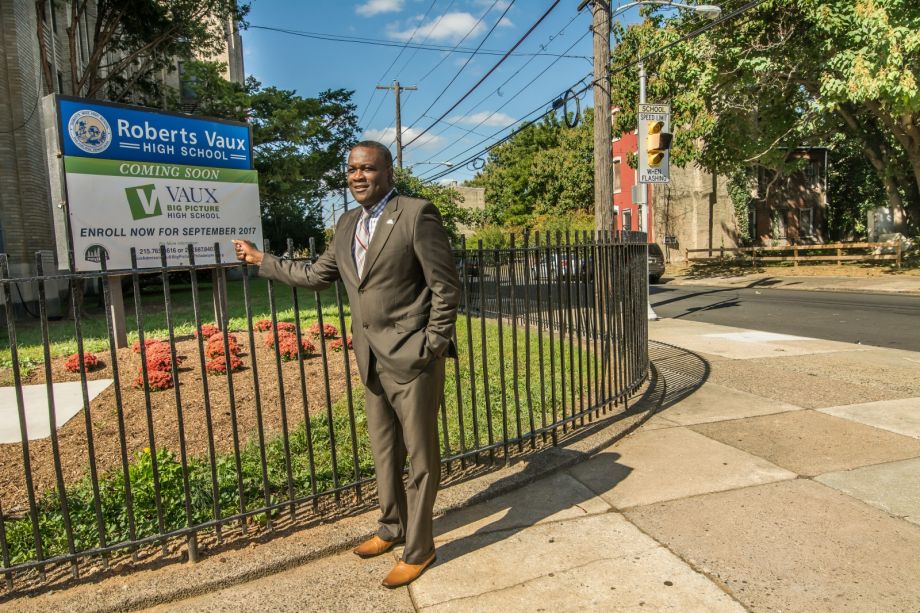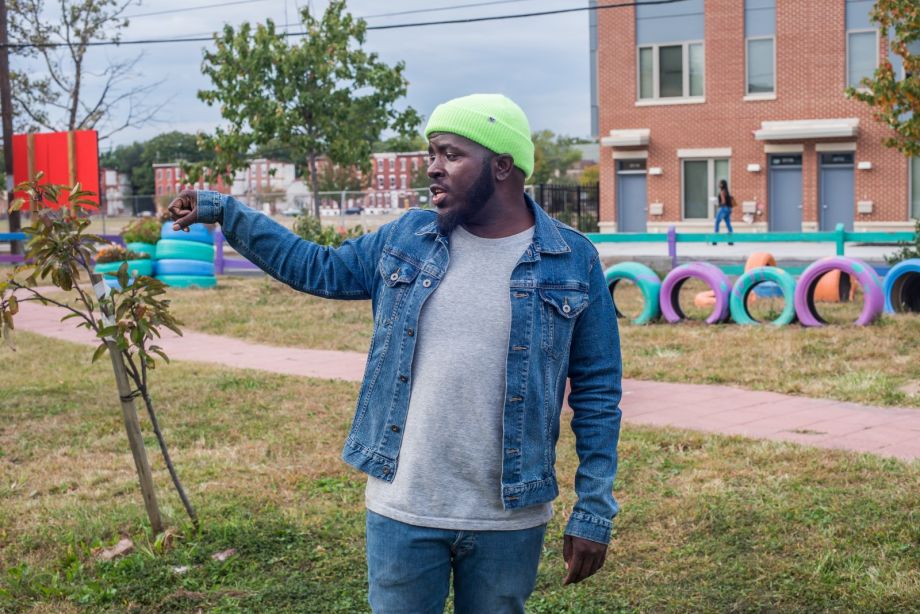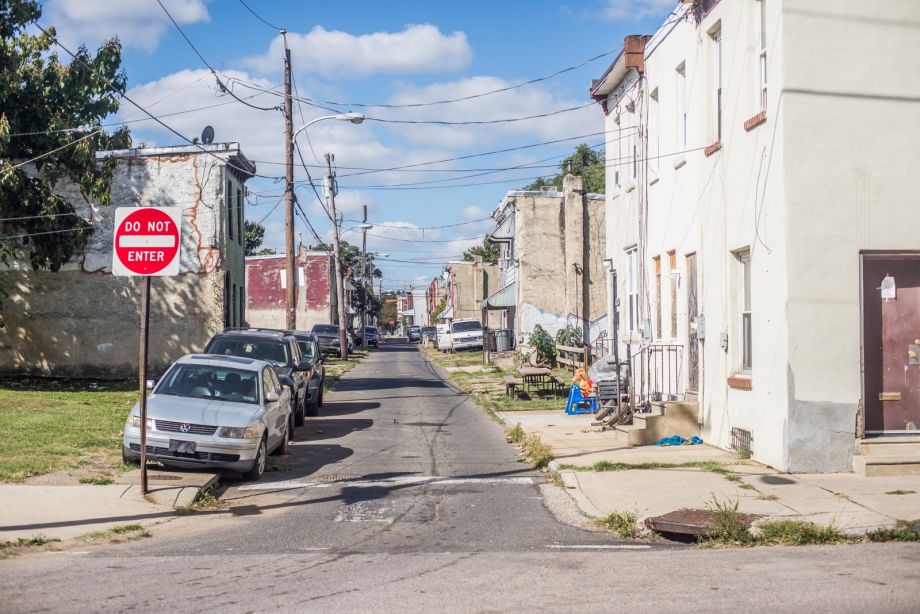Are You A Vanguard? Applications Now Open
Students and advisers in a class at the new Vaux Big Picture High School in Philadelphia
This is your first of three free stories this month. Become a free or sustaining member to read unlimited articles, webinars and ebooks.
Become A MemberDebbie Thomas’ neighborhood has been called many names over the years, from plain-old North Philadelphia to Brewerytown to the now-in-vogue Sharswood. But whatever the moniker, the area has steadily become known for something else: crime and poverty.
Thomas moved away from Philly once, and returned in 1984 to live in her childhood home, where she remains. In the last few decades, she has seen continuity on her immediate block: There are many families and it’s been predominantly black for generations. But she’s noticed change in the wider neighborhood. The cookouts became a little less frequent, the tree canopy thinned, and the sense of trust among residents — the kind Thomas grew up with, where neighbors took care of each other’s kids — disintegrated. “All of that seemed to vanish in the twinkle of an eye,” Thomas says.
According to 2013 Census Bureau data, between 1999 and 2013, median household income declined by nearly 28 percent in Thomas’ ZIP code, 19121. More recent census data shows that 41 percent of families are living below the poverty line inside Sharswood’s two main census tracts. As a teenager, Thomas feared violence when she strayed too far (and into the white neighborhoods beyond); now she’s grown accustomed to it being nearby. “When I raised two children here, they said nothing good can come out of North Philly because there were gang wars and all sorts of crazy things going on,” Thomas says.
But lately, Thomas has found optimism in an unlikely source: the Philadelphia Housing Authority (PHA), the same agency she blames for the decline. “PHA is the worst as far as property owners,” Thomas says, referring to the drugs and violence that festered in nearby public housing for decades. In March 2016, PHA imploded two out of three of the Norman Blumberg Towers, a 510-unit housing project, and began fulfilling a master plan for transforming the neighborhood that calls for new homes alongside a renaissance of commercial activity.
One key ingredient of that envisioned turnaround — a high school, three blocks away from where Thomas lives — came to life in early September. For decades, the 4-story Roberts Vaux High was known for its championship chess team, but in 2013, it closed as part of a larger reorganization within the Philadelphia School District that saw the controversial shuttering of 23 neighborhood schools. Before Philadelphia children returned to school this fall, Vaux reopened. In unorthodox fashion, PHA is the landlord.
The authority, which owns more than 14,000 public housing units in the city, bought the Art Deco building that houses Vaux from the Philadelphia School District in May. It then enlisted a nationally acclaimed nonprofit education operator and refurbished the building for an inaugural ninth-grade class that’s now underway.
Of all the organizations to tackle the intractable problem that is Philadelphia’s public schools, PHA — which has been beset by scandals and a severe housing shortage in recent years — seems an unlikely candidate. Yet, to PHA President and CEO Kelvin Jeremiah, opening a high-performing, alternative-curriculum school in Sharswood makes total sense.
Replacing a high-rise with 57 quaint, affordable rental units was among the first steps in the dramatic Neighborhood Transformation Plan, which is set to unfold over the next several years. Spearheading the reopening of a once-beloved neighborhood school is another step — and one that could help families in public housing get the skills they need to increase income and guard against displacement amid changes that Jeremiah hopes to see in Sharswood. He envisions a revamped Vaux as an anchor in a mixed-income neighborhood effort that will help to reduce poverty.
Thomas, for one, applauds the progress made by PHA so far. “They took down the projects and put some beautiful homes there,” Thomas says. “I’m very happy to see the gentrification coming. I’m glad to see it turned back to its old glory days.”
Not everyone agrees so wholeheartedly. To some, the high school is the only part of the PHA development worth celebrating. “Of course I’m for Vaux opening,” says one of Thomas’ friends on the block who’s in her 70s and asked that her name not be used. “But this neighborhood, it’s already changing,” she says, pointing to a younger white couple who recently moved in across the street. “I’m not looking at color, I’m looking at the generation. We’re older. Where are we gonna go? This is pushing us out.”
Finding a way to ensure that poor residents reap the benefits of mixed-income aims — without devastating preexisting communities like Thomas’ — has largely eluded planners. Yet, with its transformation plan, PHA has situated itself in Sharswood as much more than the deliverer of last-resort housing. It’s trying to usher in all the makings of a stable, low-crime community.
“Our mission is to create affordable housing, no doubt,” Jeremiah says. “But part of our mission is to create decent and safe affordable housing. We can build beautiful developments, but if they’re not safe, they’re not decent.”
In Sharswood, PHA is also building a grocery store and market-rate apartments. The authority will move its headquarters (where roughly 400 employees work) to the neighborhood from Center City. In all, it’s constructing 600,000 square feet of mixed-use development, along with 1,200 residential units.
“The idea that [PHA was] sitting on all these parcels, all the property we have here, allowed us the opportunity to de-concentrate the levels of poverty … and to rebuild the community, making it a neighborhood of choice,” Jeremiah says.
If the plan pans out, Sharswood could be an affordable Philadelphia neighborhood that’s not isolated from the gentrification happening around it; rather it could become an inclusive part of it.
“Fairmount is only a few blocks away, where property values are skyrocketing,” Jeremiah says. “Francisville, Brewerytown, Center City — all of that is only a stone’s throw away.”

Kelvin Jeremiah, president and CEO of the Philadelphia Housing Authority, stands in front of Vaux Big Picture High School.
Property values of homes with mortgages in Sharswood doubled between 2010 and 2015, according to calculations using census data, although most of the gains have been realized since 2013. Jeremiah believes that’s no coincidence: The first outline of the transformation plan emerged publicly in 2014. Thomas, too, says speculators have made offers on her block. (She notes she has a message for them: “We plan on dying here.”)
Anchoring a neighborhood with a high-performing school is one way PHA hopes it can lift up the educational attainment and poverty levels of longtime residents, rather than changing the picture simply by replacing those residents with higher-income individuals.
According to 2015 census data, the census tract directly south of Sharswood has a poverty rate in the single digits, and median household income increased 16 percent between 2010 and 2015, up to more than $55,000 per household. It lies within Fairmount, a neighborhood where posh apartment towers have gone up in the last decade and average home values are north of $300,000. Whereas in Fairmount more than half the adult population has a bachelor’s degree or higher, in Sharswood, roughly a quarter have less than a high school diploma or equivalent. The unemployment rates are similarly disparate.
In the three years since PHA released its transformation plan for Sharswood — which Philadelphia Inquirer architecture critic Inga Saffron described as having a “suburban mentality” — development has quietly been marching ahead.
“A critic is like an ass. Everybody has one,” Jeremiah says. “This transformation plan wasn’t developed in the ivory tower of my office. The community drove this plan.” PHA will track residents’ feelings about the development over time, in partnership with the University of Pennsylvania.
There’s no more emblematic sign of that community-driven process, Jeremiah believes, than the new-look Vaux.
Even onetime detractors of PHA’s Sharswood transformation plan are now inclined to support the reopening of Vaux high school.
“We definitely think it’s a step forward in the right direction, [PHA] opening up Vaux as a school and not a condo or lofts,” says Pili X, the director of community partnerships at the North Philly Peace Park.
To pave the way for so much development, PHA seized dozens of occupied homes via eminent domain. A couple years ago, residents protested after the authority acquired and placed a fence around the original Peace Park, which was started in 2012 as an agriculture and education center on a vacant lot. But Peace Park was given a new location just a few blocks away, and the operators now hold a decades-long lease and have land security. (When U.S. Housing and Urban Development Secretary Ben Carson cut the ribbon on Vaux in September, more protests ensued.)
“It’s been very fruitful for us,” Pili X says about the past season in the current lot. “An abundance of produce.” He now describes the relationship with PHA as cordial and productive.
In fact, it turned around when PHA committed to repurposing Vaux in a way that would benefit current residents. “We want to work closely with Vaux,” X says. “We want to pull in those young people to our after-school programming and alternative schooling. It was a sign of good faith, PHA opening back up the school.”
Jeremiah gave me a tour of the high school in July as it was being vigorously renovated some six weeks before the first day of class. This year, 126 ninth-graders are using seven classrooms, which is about 20 percent of the building. Next year, there will be a class of both ninth- and 10th-graders occupying the space. Plans call for adding one grade each year until it’s a ninth through 12th school that retains small class sizes.
As a condition of buying the building (which is on the National Register of Historic Places) for $2 million, PHA agreed to pump in up to $15 million in renovations. The work has included the mass removal of locking, jail-like bars on the classroom doors, swapping chalkboards for dry-erase boards, and outfitting the cafeteria with colorful decor. Original terrazzo flooring has seen some restoration, adding to the aura of a Tudor-arched entrance and a staircase draped in stained-glass lighting.

Pili X shows off the North Philly Peace Park where he serves as the director of community partnerships.
You can buy a lot of houses in Philadelphia with $15 million, so that much spending from an agency with a severe backlog of affordable housing needs has naturally raised eyebrows. The Sharswood development is also connected to the HUD program Moving to Work, launched during President Bill Clinton’s administration, which has given public housing agencies broad license to implement innovative ideas beyond their traditional scope of work. In 2015, the think tank Center on Budget and Policy Priorities found that Moving to Work has “fostered some useful innovations but has also had serious adverse effects.” Some of the funding for the Sharswood initiative is from HUD but much of it is coming from PHA’s regular capital and operations budget.
Executing the Sharswood master plan will be a legacy-defining project for Jeremiah, whose name has been floated in the past as a future mayoral candidate in Philadelphia. What the legacy will be, however, depends on whether PHA achieves its goals. For better or for worse, the transformation is underway. “The school is opening in September, come hell or high water,” Jeremiah told me in July. “We have a waiting list for the school and it hasn’t even opened. So why wait?”
On the second day of school this September at the new Vaux Big Picture, as the Sharswood high school is now named, the school had 100 percent attendance. Students and advisers (what teachers are called) wore navy blue shirts and got acquainted with a different sort of curriculum. There’s a class that’s called “Social Reasoning,” another that’s called “Real World Learning.” A slice of shared space is dedicated to restorative justice and meditation. In the biochemistry class “Empirical Reasoning,” students tackled a project on self-identity that doubled as a lesson in genetics.
Big Picture Learning is the national nonprofit that PHA contracted to run the school. If skeptics are wary of the housing authority’s ambitious aims for a mixed-income Sharswood, they might be even more bewildered by its doubling down on an experimental education model.
Still, last winter, BPL established an office in a Sharswood church, to provide an information center for the public. BPL made dozens of community presentations. Every family got a home visit from an administrator in the six months leading up to the first day.
“The foundation of every school is the relationships that you have,” says David Bromley, the executive director of Big Picture Philadelphia. “We’re a school that prides itself on being a school without walls.”
The reopened Vaux is classified as a district-run “contract school.” Contract schools are somewhere between a public and a charter. Historically, the Philadelphia School District has used them as alternative-education facilities, for over-age and under-credited students, or those with special disciplinary concerns. The district retains ultimate authority, but relies on an outside company for the daily administration.
From the district’s perspective, outsourcing day-to-day school operations via contract with an outside provider can be advantageous in a number of ways.
“It allows us to aggressively meet the needs of our students,” says Christina Grant, assistant superintendent with the school district’s Opportunity Network, the group of the city’s alternative schools.
Vaux is the first contract high school that has opened since Philadelphia School District Superintendent William R. Hite Jr. arrived in 2012. It is also the first contract high school for students of traditional ages and abilities to open in the district period. The curriculum is unconventional and designed to supply real-life work experience. In Vaux’s 10th-grade school year, all students will participate in an outside internship two days every week. Big Picture Learning prioritizes self-directed and project-based learning, often organized around the interests that students discover during internships. “Contracts are really interesting because we’re able to collect data with a controlled group of students,” Grant also notes.
Another advantage can be the outside provider’s ability to isolate fundraising for the contract school.
Vaux, through Big Picture, has already received more than $835,000 in grant funding from the Philadelphia School Partnership, a nonprofit that has disrupted the local education landscape by funding unconventional school models throughout the region in charter, private and district schools.
Grant dismisses comparisons of Vaux to a charter school. “Don’t let the word ‘contract’ deceive you,” she says. “This school is treated like a traditional high school.”
Vaux will be staffed by teachers under the same contract that governs the entire district. It will pull its student population from the immediate neighborhood before offering a lottery to North Philadelphia, and then to those around the city.
Bromley, too, helps clarifies nuances of the unique arrangement. “Teachers are school district employees represented by PFT, like every other school district teacher,” he says. “Totally the same.” (Multiple phone calls to the Philadelphia Federation of Teachers were not returned.)
Some public school advocates think it still sounds a lot like a charter in sheep’s clothing. “Once you begin these contracts, they are no longer public schools,” says Barbara Dowdall, a former teacher at Vaux and a member of the Alliance for Philadelphia Public Schools (APPS). Dowdall points out that Christina Grant once worked for charter operator Great Oaks Foundation. Grant says that she, as an employee of the district, tries to “remain agnostic on the governance structure” of schools, as long as they provide quality education.
Karel Kilimnik, co-founder of APPS, believes reopening Vaux as a Big Picture school is mostly about branding, to shine a positive light on a school district that’s had little of it in recent memory. “It’s about PR more than anything else,” Kilimnik says. “Foundations want to give money for new schools.”

While this North Philadelphia neighborhood has been called many names over the years, it's now most commonly referred to as Sharswood.
The district has longstanding funding woes. The Republican-controlled Pennsylvania legislature — the state took control of the district in 2001, due to its financial difficulties — has hardly been sympathetic, and increased federal funding from Betsy DeVos’ Department of Education is unlikely to come down the pike.
“We wanted the flexibility to have a contracted neighborhood school with all of the benefits that would be kind of Penn Alexander-like,” says Jeremiah, referring to one of the most popular schools in the district where critics blamed the enrollment process for favoring families with more resources before the school moved to a lottery system in 2013. “Except here, we’d have the true beneficiaries of the high-performing school be families from the neighborhood.”
In a neighborhood with high poverty and an unemployment rate above the citywide average, a school curriculum that so tangibly connects to real-world jobs has appeal. During Big Picture students’ yearlong independent projects on topics they’re interested in, they work with a mentor who has had career experience in a similar or related field. The idea is not only to personalize schooling and to facilitate their ownership over their education, but also to provide students with the opportunity to hone employable skills.
“We chose to open the school right away because we don’t want to lose any of the children in the 57 [public housing] units that are already occupied, along with the PHA sites that are scattered across the neighborhood,” Jeremiah says. “If we’re going to rebuild and transform this community, we need to have anchor institutions. PHA is putting its money where its mouth is, in terms of the commercial corridor piece. And now Vaux is doing that for education.”
Another idea for improving the overall well-being of the neighborhood came out of PHA interviews with residents: expanding career workshops and adult education. Given the ample square footage of the school building, PHA could deliver on some of its workforce training goals by housing them within Vaux. The authority has already brought other social services inside. This fall, health and dental clinics are scheduled to open on the ground floor of Vaux (with a separate entrance from the school), along with financial counseling and a human services agent. These are available to community members of all ages.
But ultimately, the foundation of PHA creating an economically upward community will be the public education that’s available to its children. The same could be said of the city overall: As schools go, so does the community.
“It’s something sacred when you bring a school back online,” says Grant. “This was an amazing opportunity to bring an amazing high school provider to a community that deeply needed a strong option.”
The excitement of a new school — with no older students — has rubbed off on the new ninth-grade class. In the first week, students raved about the food in the cafeteria, the orientation Outward Bound trip and the visits to various businesses in the city that could be locales for their internships next year. “There are a lot of gates that are going to be opened for us,” says student Jamia Whitehurst. “You expect a high school to be great, but not every one is. I like Vaux because we’re actually building a school.”
As Sharswood continues to see the rollout of the transformation plan, and if higher-income individuals put down roots, the demographics of the student body will likely shift. When Vaux shuttered in 2013, it was partly due to declining enrollment. The more families that come to Sharswood, the better the chances that Vaux doesn’t close yet again, and students like Whitehurst will be able to go after their dreams.
“I want to own my own business. I want to be a veterinarian. I want to do cosmetology,” she says. “Before this is all over, I want to go to Harvard University.”
Editor’s Note: The original version of this article had a quote by Karel Kilimnik that was missing important context. APPS is opposed to using private vendors to manage public schools.
Next City's coverage of Philadelphia’s changing neighborhoods is made possible with the support of the William Penn Foundation.

Malcolm was a Next City 2015 equitable cities fellow, and is a contributing writer for the Fuller Project for International Reporting, a nonprofit journalism outlet that reports on issues affecting women. He’s also a contributing writer to POLITICO magazine, Philadelphia magazine, WHYY and other publications. He reports primarily on criminal injustice, urban solution and politics from his home city of Philadelphia.
Joshua Scott Albert is a Philadelphia-based photographer and reporter. He's contributed to VICE, Buzzfeed, Philadelphia Magazine and several other outlets.

20th Anniversary Solutions of the Year magazine